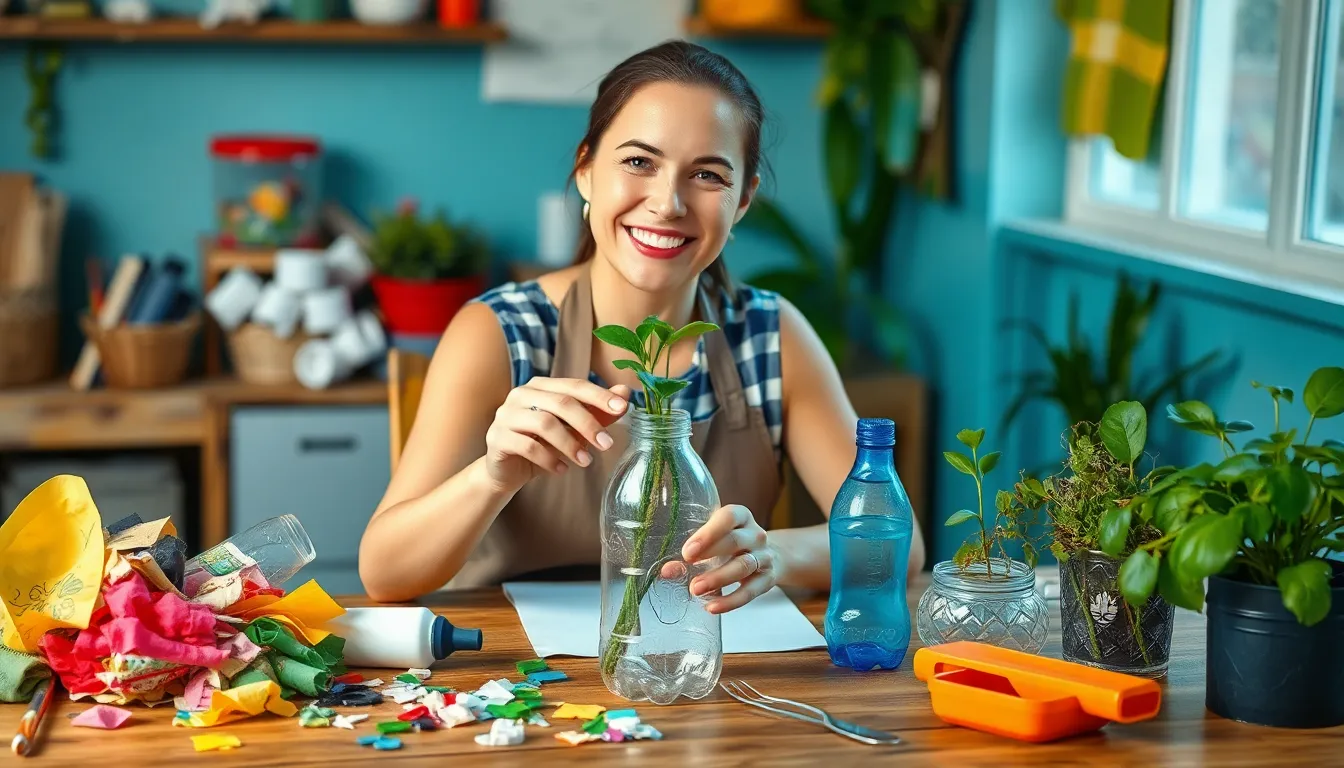Table of Contents
ToggleIn a world increasingly focused on sustainability, green crafts have emerged as a creative solution to environmental challenges. These eco-friendly projects not only reduce waste but also inspire individuals to rethink their relationship with materials. From upcycling everyday items to using natural resources, green crafts offer a fun and meaningful way to express creativity while contributing to a healthier planet.
Whether it’s transforming old clothes into stylish tote bags or crafting with recycled paper, the possibilities are endless. Engaging in green crafts fosters a sense of community and encourages a lifestyle that values resourcefulness and creativity. By embracing these practices, crafters can make a positive impact on the environment while enjoying the therapeutic benefits of crafting.
What Are Green Crafts?
Green crafts represent a creative approach to addressing environmental issues through sustainable practices. These activities focus on reducing waste by upcycling materials and selecting eco-friendly resources. Crafters engage in projects that utilize items that might otherwise end up in landfills, such as turning old clothes into tote bags or transforming glass jars into decorative storage containers.
Green crafts primarily emphasize the use of natural or recycled materials. Crafters often work with resources like reclaimed wood, fabric scraps, and biodegradable glues. By choosing sustainable options, they not only lessen environmental impact but also inspire others to rethink material consumption.
Community involvement characterizes green crafts. Local workshops and crafting groups encourage individuals to share skills and knowledge, reinforcing the idea that creativity can lead to meaningful change. Participants learn from one another, fostering a sense of resourcefulness and collaboration that extends beyond crafting.
In essence, green crafts contribute to a more sustainable lifestyle while offering therapeutic benefits. They empower individuals to express creativity, connect with their environment, and actively participate in eco-friendly practices.
Benefits of Green Crafts

Green crafts offer numerous advantages, contributing both to environmental sustainability and individual well-being. They serve as a powerful tool for creating positive change in various aspects of life.
Environmental Impact
Green crafts significantly reduce waste and promote recycling. Crafters utilize discarded materials, decreasing landfill contributions and promoting resource conservation. For instance, upcycling plastic bottles into planters or using scrap fabric for quilts minimizes the need for new materials. Additionally, green crafts lower carbon footprints by encouraging local sourcing of supplies, which reduces transportation emissions. These creative practices advocate for sustainable lifestyles, reinforcing the importance of environmental stewardship.
Personal Benefits
Green crafts provide numerous personal advantages, including enhanced creativity and stress relief. Engaging in these activities fosters mindfulness, allowing individuals to connect with their surroundings and work through stress. Crafting also promotes skill development, as participants learn new techniques and share knowledge within their communities. Moreover, creating items from reclaimed materials instills a sense of accomplishment, enhancing self-esteem. Social connections flourish through crafting groups, strengthening community ties while supporting eco-friendly initiatives.
Popular Types of Green Crafts
Green crafts encompass a variety of projects that utilize eco-friendly materials, encouraging sustainability. Popular types of green crafts include creations using upcycled materials, natural dyes, and handmade paper.
Upcycled Materials
Upcycled materials transform discarded items into useful or artistic creations. Crafters often use old clothing, furniture, and even plastic items in innovative ways. Examples include converting t-shirts into reusable shopping bags or repurposing wooden pallets into garden furniture. This practice not only reduces waste but also inspires creativity, allowing individuals to express their unique style through customized projects. Upcycling contributes significantly to environmental conservation by minimizing landfill waste and promoting resourcefulness.
Natural Dyes
Natural dyes provide an eco-friendly alternative to synthetic coloring agents in craft projects. Made from plants, fruits, and other organic materials, they create vibrant hues while reducing chemical runoff. Common sources for natural dyes include turmeric for yellow, beet juice for pink, and indigo for blue. Crafters often use these dyes in fabric projects, such as tie-dyeing or dyeing yarn, to achieve beautiful, sustainable textiles. Using natural dyes fosters a connection to nature and encourages sustainable practices, as it relies on renewable resources.
Handmade Paper
Handmade paper crafting involves recycling used paper into new sheets, significantly reducing the need for industrial paper production. This craft allows individuals to utilize scraps from discarded paper products like magazines and office waste. The process may include soaking, blending, and molding paper pulp into new forms. Handmade paper often features unique textures and colors, providing crafters with a versatile medium for art, card-making, and journaling. Additionally, this eco-friendly practice promotes awareness of paper consumption and encourages responsible resource management.
Tips for Getting Started with Green Crafts
Getting started with green crafts requires thoughtful choices regarding materials and techniques. By following essential tips, crafters can enhance their eco-friendly projects and promote sustainability.
Selecting Materials
- Choose recycled items like cardboard, glass, and plastic for new projects. Using readily available materials reduces the demand for new resources.
- Opt for natural materials such as wood, stone, and organic fabrics. These options minimize environmental impact compared to synthetic materials.
- Utilize existing resources around the home, including old clothing and furniture. This practice encourages creativity and resourcefulness while reducing waste.
- Investigate local sources for materials like scrap fabric or leftover supplies. This strategy supports the community and promotes a lower carbon footprint.
- Avoid harmful chemicals in products by choosing non-toxic glues, paints, and finishes. This approach ensures safer crafting environments and protects the planet.
Tools and Techniques
- Use hand tools like scissors and craft knives instead of electric tools. Manual tools often consume less energy and promote a hands-on crafting experience.
- Incorporate upcycling techniques to create new items from discarded ones. For example, transforming glass jars into candle holders or t-shirts into reusable bags illustrates this method.
- Practice natural dyeing using fruits, vegetables, or plants. This technique connects crafters to nature while offering eco-friendly alternatives to synthetic dyes.
- Explore simple crafting methods that don’t require extensive tools. Techniques like weaving or stitching can often be accomplished with minimal equipment.
- Engage in collaboration with local crafting groups to share skills and techniques. Collaborative efforts foster creativity and build community ties while promoting resource sharing.
Green crafts offer a unique opportunity to blend creativity with environmental responsibility. By engaging in these eco-friendly projects, individuals not only reduce waste but also cultivate a deeper connection to their surroundings. The joy of transforming discarded materials into something beautiful fosters a sense of accomplishment and community.
As more people embrace these sustainable practices, the impact on the environment becomes increasingly significant. Each project contributes to a larger movement toward mindful consumption and resourcefulness. Whether working alone or in groups, crafters are empowered to make a difference, proving that creativity can indeed lead to positive change.


